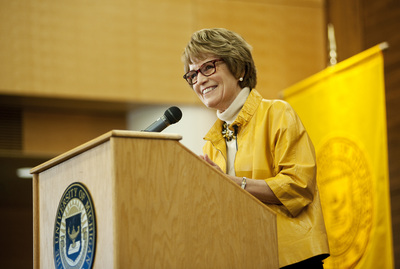For more than 18 months, it's been an oft-quoted figure: There are an estimated 70,000 to 80,000 unfilled jobs in Michigan because the workforce here doesn't have enough technical skills to fill the demand.
With the statistic comes the worry that Michigan can't attract enough talent to facilitate a strong economy.
While the state's three research universities —Wayne State and Michigan State universities and the University of Michigan— produced 14,000 graduates with high-demand degrees in 2011, many of them left the state not long after walking across the commencement stage.

Mary Sue Coleman speaks during a October 2012 press conference.
Daniel Brenner | AnnArbor.com file photo
About 40 percent of U-M alumni live in Michigan.
"I've not heard about students leaving the University of Michigan destitute and unable to get jobs. I hear they do quite well and many of them leave the state," said U-M President Mary Sue Coleman, who spoke Monday during an Inforum luncheon at the Renaissance Center in Detroit. "Shame on us if we can't convince the students to come and look at the opportunities in Michigan. We don’t do enough of that."
Lou Anna K. Simon, president of MSU, and Deborah Wince-Smith, president of the Council on Competitiveness, joined Coleman in a panel discussion about global competitiveness that also touched on the state's need for technical employees.
Coleman said U-M's engineering school is at capacity, spending millions to immerse students in real-word situations in technology fields, and shifted some of the burden of combatting the state's brain drain to businesses.
State corporations, Coleman said, have to do more to convince recent college graduates to stay in state.
"It’s as incumbent on corporate America as it is on the universities to say if we can't attract the students, why? What is it that’s failing?" said Coleman, who serves as co-chair of President Barack Obama’s National Advisory Council on Innovation and Entrepreneurship.
"It would help if the companies let the students know they want them," she continued. "Think about some innovative recruiting. We've got them captive on our campuses and we can do all we can to say things about the opportunities we have in Michigan ... but if there's nothing on the other side it's a little tough."
According to a recent economic impact report, WSU, MSU and U-M have more than 1.1 million living alumni worldwide, with 590,000 living in Michigan in the summer of 2012. Alumni of the three schools account for 7.8 percent of the state's adult population.
As of July, 211,000 U-M alumni, out of a total of 525,000 living alums, live in the state. Roughly 41,000 alums live in California, a state brimming with companies seeking graduates with high-demand degrees.
U-M spokesman Rick Fitzgerald said the school does not have data sorted by residency of recent graduating classes.
Meanwhile, the number of high-demand degrees produced by U-M is growing. For example, U-M conferred more than 1,500 engineering degrees in 2012, up from about 1,230 a decade earlier, according to school records.
"We are both running flat-out at capacity," Coleman said of U-M and MSU's engineering programs. "Young people are getting the message, they want to be educated in engineering but it isn't free."
Because of the technology involved in studying the field, running engineering departments is expensive. Simon said that if MSU is going to grow its engineering program, it needs more money for labs, faculty and infrastructure. She said MSU is working with other state colleges on seeking financial support from the state in order to grow high-demand programs.
"There are plans that can be put in place to grow the number of engineering students in Michigan," Simon said. "It would require some money."
Added Coleman: "At the end of the day it's going to be a decision about funding."
Simon said that the livability of the state also is a factor in retaining graduates. She said many students graduate from MSU and move to "cool urban environments" where there's a lot of jobs, but also a diverse social scene.
Chicago is one of the most popular launching pads for recent college graduates from Michigan. Nearly 26,400 U-M alumni live in Illinois, while 25,400 live in New York.
"They will go there without a job in some cases," Simon said, adding that the continued revitalization of Detroit can help attract students to the state. "Detroit is really critical to our success."
Kellie Woodhouse covers higher education for AnnArbor.com. Reach her at kelliewoodhouse@annarbor.com or 734-623-4602 and follow her on twitter.